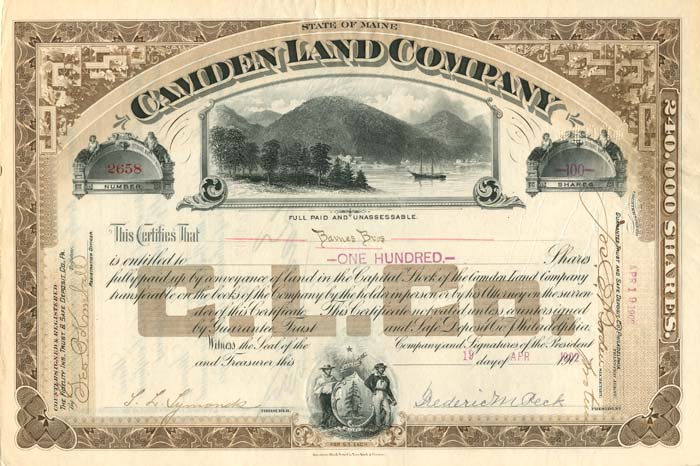Camden Land Co. - Stock Certificate
Inv# RE1043 Stock
Stock printed by American Bank Note Co., New York & Boston. Superb!
Camden is a town in Knox County, Maine, United States. The population was 4,850 at the 2010 census. The population of the town more than triples during the summer months, due to tourists and summer residents. Camden is a summer colony in the Mid-Coast region of Maine. Similar to Bar Harbor, Nantucket and North Haven, Camden is well known for its summer community of wealthy Northeasterners, mostly from Boston, New York and Philadelphia.
The Penobscot Nation have lived in the area for thousands of years. They called it Megunticook, meaning "great swells of the sea", a reference to the silhouette of the Camden Hills (more visibly seen on a bright night). Although part of the Waldo Patent, Europeans did not attempt to colonize it until after the French and Indian War, around 1771–1772. They were led by James Richards, who built a home at the mouth of the Megunticook River. Others soon followed, squatting on Penobscot land and attempting to farm the broken and often mountainous terrain. The first home in the area was the Conway House, a Cape Cod style home built in 1770. In 1962, it was purchased and renovated into a history museum.
When Castine was held by the British in 1779, Camden became a rendezvous point and encampment for the Americans, who were commanded by Major George Ulmer. During a raid, the British burned a sawmill. On February 17, 1791, the Massachusetts General Court incorporated Megunticook Plantation as Camden, named after Charles Pratt, 1st Earl Camden, a member of the British Parliament and proponent of civil liberties. During the War of 1812, a battery was built atop Mount Battie near the village. It had both a 12- and 18-pounder gun, but no gunner qualified to operate them. Nevertheless, the fort's appearance of readiness kept the British at bay.
When peace returned, Camden grew rapidly. The Megunticook River provided excellent water power sites for mills. In addition to sawmills and gristmills, by 1858 the town had carriage factories, sash and blind factories and blacksmith shops. There were six shipyards, launching ten to twelve vessels annually. By 1886, the town also made foundry products, railroad cars, woolens and paper mill feltings, anchors, wedges, plugs and treenails, planking, powder kegs, excelsior, mattresses, powder, tinware, oakum, wool rolls, boots and shoes, leather, flour and meal, corn brooms and barrels. Camden was second only to nearby Rockland in the lucrative manufacture of lime, excavated at quarries and processed in kilns before being shipped to various ports around the United States until 1891, when Rockport was set off as a separate town. As the 19th century came to an end, Camden was very much a shipbuilding town with the H.M. Bean Yard launching the largest four-masted schooner Charlotte A. Maxwell and the first six-master ever built-the George W. Wells.
In the 1880s, sportsmen and "rusticators," began to discover the natural beauty of Camden during the summer and autumn, becoming seasonal residents. Sarah Orne Jewett's stories of nostalgia for the sea, Camden's scenery, fine old homes of sea captains, and the paintings of Fitz Hugh Lane, Frederick Church, and Childe Hassam evoked a romantic vision of Maine and induced many to come to stay at the Bayview House Hotel, Ocean House, and Mrs. Hosmer's Boarding House. In 1880, Edwin Dillingham built the first purpose-built summer cottages in Camden on Dillingham Point. Thereafter, the summer colony at Camden quickly grew to include some of the wealthiest, most prominent families in the country. These new summer residents from Philadelphia, Boston, New York, Washington, D.C. and even Chicago, built large, rambling Shingle Style "cottages" along High Street, Bay View Street and on Beauchamp Point to rival those in Bar Harbor. The summer people arrived on the Boston Boats or on the Maine Central Railroad at Rockland. Local residents, who had formerly gone to sea to earn a living, found jobs as caretakers, gardeners, and carpenters to the rich and powerful.
In November 1892, a fire fed by a strong easterly wind-burned the business district to the ground. Immediately, Camden businessmen drew together to make the investment required to build 12 large brick buildings, including the Camden Opera House and, controversially, the Masonic Temple (now the Lord Camden Inn). The Great Fire, as it became known, did not, however, discourage increasing numbers of affluent summer people from making Camden their summer enclave. Indeed, in 1897 a road was built to the top of Mt. Battie, one of the two mountains rising above the town, and an inn was erected at the summit. In 1898, a group of wealthy summer residents from Philadelphia established the Megunticook Golf Club on Beauchamp Point. And in 1901, the Whitehall Inn opened on High Street in an old mansion built by a sea captain, catering to a well-to-do clientele. Around the turn of the century families such as Curtis, Bok, Keep, Gribbel, Dillingham and Borland not only built estates but their donations resulted in the public library, the amphitheatre, which was designed by Fletcher Steele, the Camden Harbor Park, which was designed by the Olmsted Brothers, the Village Green, and the Camden Opera House.
A stock certificate is issued by businesses, usually companies. A stock is part of the permanent finance of a business. Normally, they are never repaid, and the investor can recover his/her money only by selling to another investor. Most stocks, or also called shares, earn dividends, at the business's discretion, depending on how well it has traded. A stockholder or shareholder is a part-owner of the business that issued the stock certificates.









Ebay ID: labarre_galleries